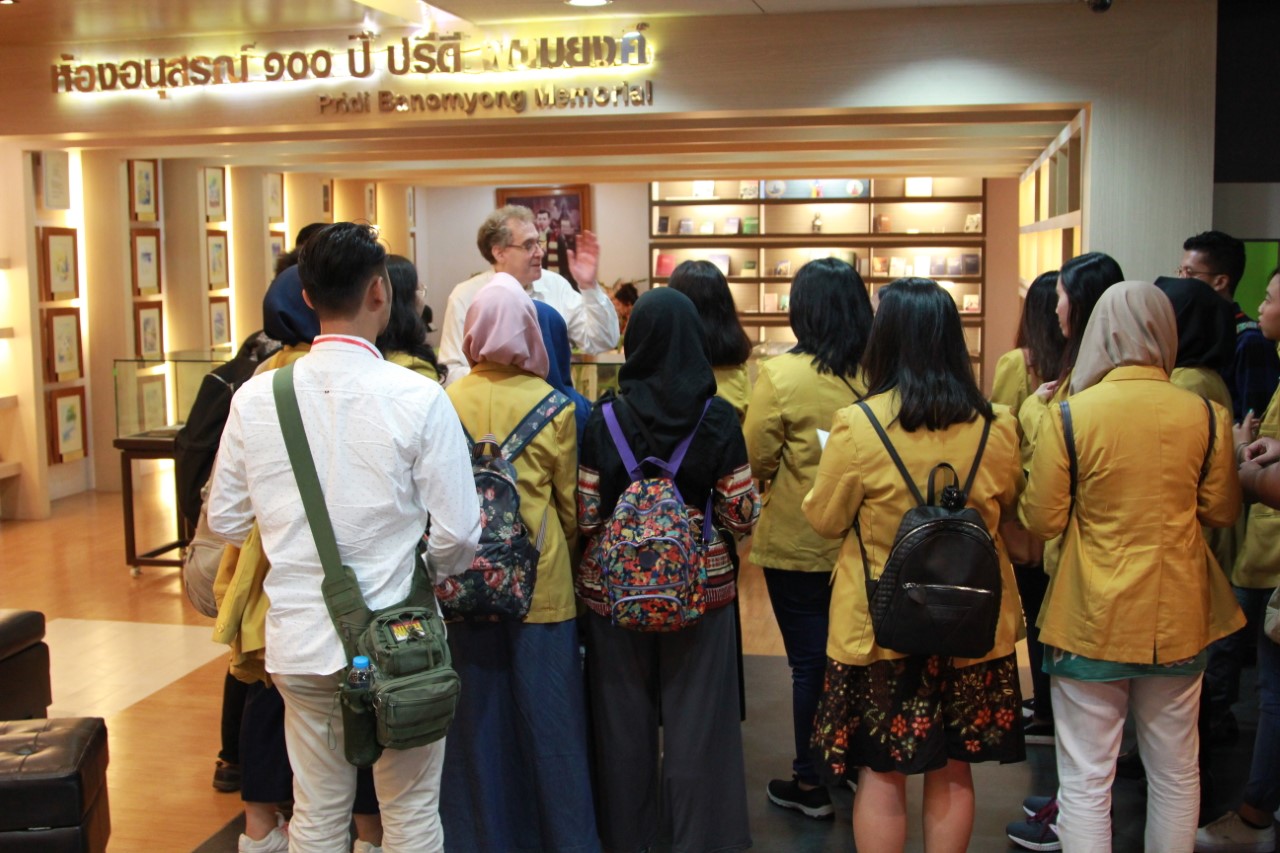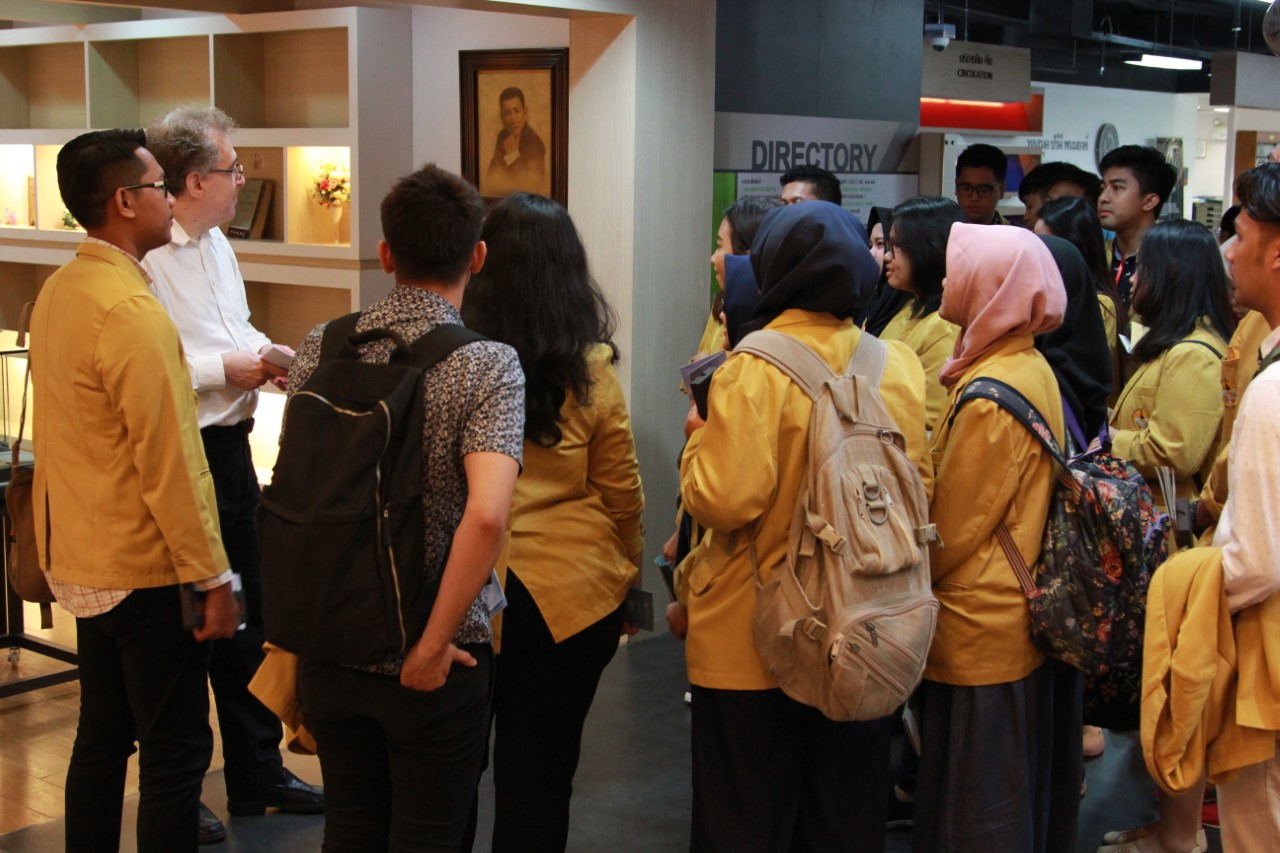
On May 9, 2018, students and ajarns from the Department of Indonesia visited the Pridi Banomyong Library, Thammasat University, Tha Prachan Campus. The group was led by two lecturers, Sri Wijayanti and Nurul Azizah Zayzda. Jenderal Soedirman University is located in Purwokerto, Indonesia. Purwokerto is located in the middle of Java Island in the province of Central Java near the base of Mount Slamet, the second-tallest volcano in Central Java. The city is divided by the Kranji River. In Purwokerto’s central public square, six banyan trees stand, providing shade for the people in the area. In Purwokerto, people like to eat deep fried fermented soy bean covered in wheat flour dough and many other local specialties. In the morning, Serabi, known in Thailand as khanom khrok, or rice flour pancakes with coconut milk or shredded coconut, are also popular. There is also a local variety of the famous Indonesian dish Soto, a traditional soup made of broth, chicken, and vegetables, mixed with a spicy peanut sambal or hot sauce paste made from chili peppers, shrimp paste, fish sauce, garlic, ginger, shallot, scallion, palm sugar, lime juice, and vinegar.
When they are not enjoying tasty foods, students are busy with academic work at Jenderal Soedirman University, named after the first commander-in-chief of the Indonesian Army during the national struggle for independence. Jenderal Soedirman was born in the region. The motto of Jenderal Soedirman University is Moving Ahead, Never Retreat. When it was founded in 1963, Jenderal Soedirman University had three faculties: Agriculture, Economics and Biology. Now it has eight faculties and postgraduate programmes, comprising 31 undergraduate programs, nine master’s degree programs, and 11 three-year diploma programs. On its website, the university declares its vision to become by the year 2034, a globally recognized university in sustainable rural development and local wisdom. Its misson is
- providing high quality educational processes that will successfully produce graduates who have moral responsibilities, academic and professional competences; competitive quality; good leadership and entrepreneurship/techno-preneurship skills; abilities to identify and solve problems; and innovative capability especially rural skills to develop the countryside and the local wisdom.
- Implementing research-based technology transfer relevant to the countryside and local wisdom improvement as an effort to support the national and regional development programs.
- Developing an autonomous, transparent, accountable, and meritocratic high education management.
- Establishing regional, national and international partnerships to develop and implement science, technology, and arts.

Among its goals and objectives are to boost rural development and empowerment by using science, technology, and the arts at local, national and international levels for community empowerment.
They are inspired by the example of General of the Army Jenderal Soedirman (1916 – 1950) who began as a teacher at an elementary school. He enlisted in the military during the Second World War, despite some physical issues. He would eventually be diagnosed with tuberculosis, which shortened his life. In 1964 he was declared a National Hero of Indonesia.
The students and ajarns from Jenderal Soedirman University were especially interested to see the Charnvit Kasetsiri Room on the U1 level of the Pridi Banomyong Library. There, on the shelves, are many books from the personal library of Professor Benedict Anderson (1936 –2015), generously donated by Professor Anderson and his friend and colleague, Ajarn Charnvit Kasetsiri. As all students interested in ASEAN history know, Professor Anderson wrote many important books about Indonesia. These are in the collection of the TU Library. They include such titles as Language and Power: Exploring Political Cultures in Indonesia and a translation by Professor Anderson of Sutan Takdir Alisjahbana’s Indonesia in the Modern World.
Among the other items donated to the TU Library by Professor Anderson and Ajarn Charnvit is a copy of a book by Pramoedya Ananta Toer, personally inscribed to Benedict Anderson. Pramoedya Ananta Toer (1925 – 2006) was an Indonesian author of novels, short stories, essays, and histories who is seen as a courageous defender of human rights and the freedom of expression. Braving imprisonment and censorhip in his homeland, Pramoedya produced works that made him considered as a candidate for the Nobel Prize for Literature. Pramoedya was especially admired by Professor Anderson, whose own writings about contemporary history in Indonesia caused him to be expelled from the country in 1972 and banned from reentering. He would not be allowed to visit Indonesia again until 1998. Professor Anderson was fluent in Indonesian, Javanese, Thai and Tagalog, in addition to a number of European languages. He would die in Batu, Malang, Indonesia in 2015. At that time, he was translating a memoir, A Life Beyond Boundaries, into English. That book is also in the collection of the TU Library. According to one online appreciation of his work from 2011,
After the exclusion from Indonesia he produced a stellar range of revisionist essays on Thai and Filipino history, informed by his voracious engagement with Thai, Spanish, and Tagalog, added to earlier languages. Never much given to superficial generalizations about Southeast Asia, his approach to the region was the hard way, acquiring a language before he presumed to have anything important to say about the political culture. In all of this he was a remarkable goad and model… Ben Anderson has not been right about everything in the astonishing range of his writings, but he has never been dull or conventional. What marks everything he wrote is a bold originality, forcing us to rethink cherished assumptions by uncovering a neglected or suppressed voice… For his generation and those that followed, his has been a prophetic voice.
Another online tribute notes:
Anderson’s work was deeply rooted in Southeast Asia, with a special focus on Indonesia. His doctoral work in the late 1960s focused on Indonesia, and his most well-known book, Imagined Communities, spends a considerable amount of time examining the genesis of Indonesian nationalism during the later decades of Dutch colonial rule of the archipelago. Anderson saw in Indonesia a microcosm of the development of the idea of the nation throughout the world. Before the Dutch came, Indonesia really was a fiction. The kings of Java and Bali, the sultans of Aceh, the Toraja chiefs in Sulawesi, the Dayak elders in Kalimantan, and the Batak clans in Sumatra all had claims to various territories, but none actually imagined themselves as belonging to an organic, unitary community in any meaningful way. Even the great maritime empires of Indonesia’s past were hardly arrangements that we would understand today as anything approaching nation-states. Instead, they were ethnically dominated networks of trade, linking distance outposts of commerce and religion, but in a way that largely ignored interior populations. For the people of the interior, except for the occasional intrusion of traders upriver to retrieve coveted goods from the forest, contact was limited, if existent at all. And whether the trade ships bore the emblem of Sri Vijaya or Majapahit or the Dutch East Indian Company, it mattered little. Beyond the occasional demand for tribute, the old way of empire in the yet-unmade “Indonesia” meant little for the vast majority of people. It was merely a matter for traders, kings, and bureaucrats. Anderson linked the creation of nations, which he called “imagined communities,” with the advancement of national languages. These languages, often taken up by local imperial middlemen who wished to assert their own indigenous sovereignty against foreign occupiers, were created and popularized out of a pre-existing cultural matrix, but were nonetheless much more productions of invention than are generally thought… In Anderson’s sense, then, Indonesia is imaginary. From space, there is no obvious reason why Indonesia’s borders exist as they do, most certainly when we consider the odd lines that strike across Borneo and Papua and Timor. There is no obvious reason why Java and Sumatra should be in the same nation, but not Sumatra and Malaya. The histories of the people that make up modern-day Indonesia are certainly intertwined, but so too are those of the peoples of Malaysia and the Philippines and Thailand and southern China and even Australia. Indonesia only exists in the sense that there are people willing to believe that it does.
 (All images courtesy of Wikimedia Commons and the TU Library)
(All images courtesy of Wikimedia Commons and the TU Library)

